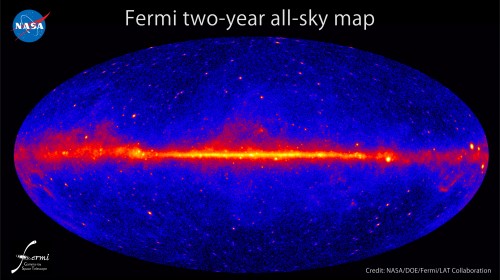Tag archives: Fermi Telescope
Neutron star merger as it happened
By Hamish Johnston
At 12:41:20 UTC on 17 August, the Fermi Gamma-ray Space Telescope sent a notice to the astronomy community saying that it had detected a gamma-ray burst. Normally such an event wouldn’t raise much fuss – but this time things would be very different.
Back on Earth, scientists working on the LIGO-Virgo gravitational wave detectors were busy analysing a signal that had arrived about 2 s before the gamma-ray burst and looked very much like the merger of two neutron stars. Such a cataclysmic event is expected to give off copious amounts of electromagnetic radiation including an initial burst of gamma rays.
View all posts by this author | View this author's profile
A possible dark-matter bubble

This all-sky image, constructed from two Fermi datasets, shows how the gamma-ray sky appears at energies greater than 1 GeV. (Courtesy: NASA/DOE/Fermi/LAT Collaboration)
By Calla Cofield at the APS April Meeting in Savannah, Georgia
The American Physical Society (APS) April meeting has been taking place in Savannah, Georgia, for the past three days. On Saturday, Tracy Slatyer from MIT spoke to reporters about a paper that she and colleagues posted on arXiv in February, in which they suggest that a mysterious excess of gamma rays surrounding the galactic centre could be explained as dark-matter particle annihilation.
The researchers use what Slatyer calls a “simple” model of dark matter, in which the invisible substance is made up of weakly interacting massive particles (WIMPs) with a mass of about 35 GeV. The model predicts that WIMPs may collide with each other and annihilate, producing gamma rays and either b-quarks or some other mixture of quarks. The Fermi Gamma-ray Space Telescope surveys the entire observable sky for the presence of gamma rays. Fermi’s observation of the plane of the Milky Way revealed that our galaxy is bright with gamma rays, but Fermi has not been able to identify the sources of all those powerful photons. Gamma-ray excesses (more than can be explained by known sources) near the galactic centre have been identified in the Fermi data in the past – most notably at about 130 GeV.
The work presented by Slatyer and her colleagues identifies an excess of gamma rays between 1 and 3 GeV. The researchers say they can see a distinctly spherical, bubble-like collection of photons. Slatyer told reporters that based on the dark-matter model, this spherical shape is not a coincidence – the dark-matter annihilation theory does not hold for a more stretched-out, elongated cluster of gamma rays; nor would it hold if the bubble were not at the centre of the galaxy.
